"NOAA and You" Education Kits
Celebrating a Continued Focus on Environmental Sciences
Explore the Earch
Web Sites
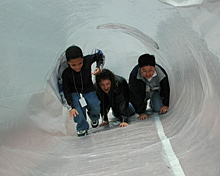
Children enjoy climging through the belly of a whale. This is one of the activities organized through NOAA Kid’s Day.
Ever wonder how satellites stay in orbit? This site gives an overview of both man-made and natural satellites, their orbits, and provides in depth information about the different functions satellites serve in communications, scientific and environmental research. For teachers, there are classroom and lab exercises, student readings, activities, interactions, and review sections. Target Audience: Grades 8-10
Environmental Visualization Program Education Collection
See what Hurricane Katrina and other major storms looked like from space! This site demonstrates some of the amazing ways satellite imagery is used in scientific research, resource management, and policy decisions. You’ll find animations and images of tsunamis, sea temperature change, even the flight track of a hurricane hunter airplane. Target: All ages
Calling all game lovers! You won’t want to miss this interactive GOES game, allowing you to play games involving weather stories (precipitation, seasons, storms, and temperature). Test your knowledge on the joke machine, or watch the latest show at the MoviePlex. There is so much to explore! Target: Educators, Parents, and Students
Underwater Exploration Timeline
Take a tour of diving history with the illustrated Underwater Exploration Timeline! Target:
Lesson Plans & Educational Products
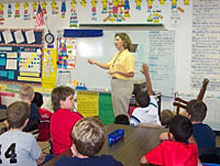
Molly Harrison of the National Marine Fisheries Service talks to students about marine life.
Increase your ocean literacy! Educators will find an amazing source of lesson plans, curricula, education modules and other teaching tools on this comprehensive site. For teachers, please find curricula from bioluminescent corals to deep-vent worms and lesson plans, also find opportunities for professional development. Target Audience: Educators
Remote Sensing and Coral Reefs
This comprehensive curriculum includes lesson plans and activities that provide students with an understanding of how remote sensing and satellites are used to monitor the environment around coral reef. The information gathered in these monitoring programs is invaluable to the agencies responsible for managing and protecting this unique ecosystem. Target: Grades 4-6
Geodesy is the science of measuring and monitoring the size and shape of the Earth and the location of points on its surface. 200 years ago, President Thomas Jefferson created the first scientific agency — the Coast Survey — which was later renamed the U.S. Coast and Geodetic Survey and became one of the first incorporated into NOAA. Today, NOAA's National Geodetic Survey is responsible for the development and maintenance of a national geodetic data system that is used for navigation, communication systems, and mapping and charting. This lesson plan/activity will explain geodesy and why it is important to us today. Target: Grades 9-12 (20 pages, PDF)
See That Sound (Hydrographic Surveying)
Hydrography is the science of measuring and describing the physical features of bodies of water and adjacent land areas that are periodically underwater (such as areas that are covered and uncovered by rising and falling tides). The most common use of hydrographic data is as an aid to safe navigation. NOAA’s National Ocean Service (NOS) conducts hydrographic surveys through its Office of Coast Survey (OCS). The OCS is the oldest scientific organization in the U.S., created in 1807 to fulfill President Thomas Jefferson’s order for a complete survey of the U.S. coast. This activity will explain the concept of sonar and describe the major components of a sonar system. Students will compare and contrast multibeam and sidescan sonar systems, and will design a relatively low-cost sidescan sonar system that could be built by an amateur ocean explorer. Target: Grades 9-12 (12 pages, PDF)
Understand the Earth
Web Sites
The Woods Hole Science Aquarium’s FAQ
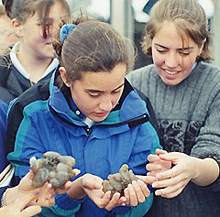
These children are examining XXXX as means of understanding more about the oceans and coasts.
How many eyes does a horseshoe crab have? Why do fish have whiskers? How long can seals and turtles hold their breath? Learn the answers to these and many other cool questions at the Woods Hole Science Aquarium. Target: All ages
Visit an estuary without leaving the classroom! Designed as an interactive program for classrooms, EstuaryLive can be viewed by anyone over the Internet. Estuaries are extraordinary places. These bays, sounds, lagoons and sloughs are inspirational sites enjoyed by boaters, swimmers, hikers and bird watchers. They are also essential to the U.S. economy for commercial fishing and tourism and buffer uplands from flooding and help protect coastal communities from severe storms. The interactive online field trip is hosted by NOAA's National Estuarine Research Reserves in collaboration with the U.S. Environmental Protection Agency's National Estuary Programs. Target: Grades K-12 (requires RealPlayer)
OceansLive is a web portal that puts the user in touch with resources on all aspects of the ocean via the web. There are live events in via the portal, a photo library, a live web cam of the Monterey Bay National Marine Sanctuary, and archived videos of past live events. Visitors can read feature articles on a variety of ocean topics and learn more about maritime heritage, the physical and living ocean, conservation and protection of the ocean, and the latest marine technology. Kids can watch videos of sea life, such as garibaldis, check out the latest cool facts and photos, and connect to a variety of fun learning activities. Teachers can download video clips to enhance their classroom presentations, search for lesson plans according to the National Science Education Standards, and link to other ocean education sites. Target: All ages and teachers (lesson plans included)
Is your family prepared in case of a thunderstorm? What about a hurricane or earthquake? This quiz will tell you if you are prepared, and help you develop an emergency plan so you can be storm safe! Target: Children and Families
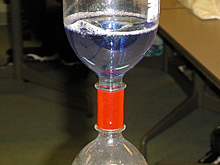
This “Tornado in a Bottle” activity helps kids understand the complex dynamics of tornado formation.
Meet Owlie Skywarn! Owlie is the mascot of NOAA’s National Weather Service and the Federal Emergency Management Agency (FEMA). Owlie has much to teach you about the hazards of severe weather, including tornadoes, lightning, hurricanes, flash floods, and winter storms! Target: Young children
This family-friendly site turns weather events into fun learning opportunities! Download coloring and activity books. Learn more about hurricanes, winter storms, tornadoes, thunderstorms, lightening, floods, safety tips, and other general weather information through games and fun activities the whole family can do together! Target: Children and Families
Lesson Plans & Educational Resources
In conjunction with the University of South Alabama, these lesson plans and student activity books have been developed for middle school students and teachers. Teaching materials cover subjects ranging from El Niño to Fisheries. Target: Middle School Students and Teachers
Ocean Explorer – Ocean Challenge Puzzle
Test your ocean literacy with the Ocean Challenge Puzzle! With each correct answer, you’ll reveal another tile of the puzzle. Collaborate with other users to reveal the full
picture. Target: All ages
Ocean Explorer – Multimedia Learning Objects
These visually stunning multimedia lessons will engage any audience. The lessons include a variety of topics, ranging from mid-ocean ridges to water cycles to ocean pollution. Target: Educators
Sea Grant is a university-based program supporting coastal resource use and conservation initiatives nationwide. This site provides an array of environmental lesson plans and curricula, with topics ranging from the Great Lakes ecosystem to underwater robotics. The site is also a wonderful resource for those considering a career in the marine sciences. Target: Teachers and environmental educators
Fisheries Learning on the Web (FLOW) is a comprehensive curriculum about the Great Lakes ecosystem. Lessons are geared toward educators who teach upper elementary and middle school students. Each lesson is aligned with national and state curriculum standards for science and social studies and features a hands-on classroom activity. Target:
Science Resource Guide Table of Contents
These printable activity sheets and science projects cover a wide range of subjects, providing parents and teachers with a wonderful way to gets kids excited about the marine environment. Target: Parents and Teachers (of young children)
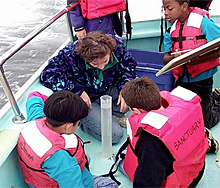
Students study a water sample taken form the Monterey Bay National Marine Sanctuary.
Much like how rings on a tree represent years, the patterns of a coral core act as a timeline and will tell you if the water temperatures were higher than normal during a particular season. Using photocopied images of actual coral cores, this activity describes the natural and scientific processes involved in paleoclimate research using coral cores obtained from the Flower Garden Banks National Marine Sanctuary and through historical events allows you to create an actual timeline from the coral. Target: Teachers (Late elementary - Middle school)
Environmental Technology Laboratory: Educational Resources
Students of all ages will be eager to learn about the physical processes that affect weather and climate. Access lesson plans, posters and publications on this useful site. Target: Elementary, Middle and High School
Are you an educator, emergency manager, or simply interested in learning about weather and weather safety? Get the information you need to remain safe during severe weather events. This comprehensive site will keep you informed and up to date. Target: Teachers, parents, and students (high school +)
National Severe Storms Laboratory
Don’t know where to start? This website provides basic information for teachers, parents, and students. Coloring books are available for elementary school age children to print and use for weather education in the classroom or at home. A comprehensive list of Teacher Resources can help with lesson plans. The site includes a good history of weather maps and symbols. Target: Teachers and Students
Teacher’s Resource for Ocean Science Education
Help promote ocean literacy! COSEE is dedicated to creating environments in which collaborations among ocean scientists and K-12 educators flourish. Educators can participate in professional development programs and join scientists as they study the Ocean and Great Lakes, and bring the materials, activities and experiences back to your classroom. Target: Educators
This comprehensive clearinghouse links to marine science education sites available online, which includes lesson plans for grades K-12, activities, education resources, teacher professional development opportunities and much more! Target: Teachers and environmental educators
Protect the Earth
Web Sites
Sustainability: It’s in Our Hands
Based on beautiful artwork depicting the complexity of marine ecosystems, this site provides information about individual species and their place in the big picture. Come learn about the fish, whales, turtles, seals, and sea lions NOAA’s National Marine Fisheries Service (NMFS) protects and works to conserve. These beautiful posters are available at no cost! Target: All ages
Office of Protected Resources: Education
Do you want to learn more about whales and marine turtles and how to help protect the ocean? Visit this website to learn about these and other fascinating sea creatures. Fact sheets and lesson plans are available to teachers and students. Target: All ages
National Marine Mammal Laboratory
Do you know what a pinniped or a cetacean is? They are marine mammals! This site provides background on all species of marine mammals, as well as career information for those who want to continue their investigation professionally! Target: All ages
Satellite Sea Turtle Tagging Project
Grays Reef National Marine Sanctuary’s Sea Turtle Satellite Tagging Project uses backpack satellite tags to monitor adult and juvenile Loggerhead Sea Turtle behavior and movement in the South Atlantic Bight. Data including an individual turtle’s position, time, and depth were electronically collected and transmitted via satellite simultaneously to scientists. The data allows scientists 1) to help explain movement and dive patterns of Loggerhead sea turtles, 2) to develop a biological model to increase the predictability of these patterns, 3) to obtain information concerning Loggerhead behavior and activity off the coast of Georgia, and 4) to explain the interactions between sea turtles and shrimp trawlers. One unique feature of the site allows you to follow a turtle’s path along the coast by plotting your own track based on the satellite data provided. Target: All ages
Lesson Plans & Educational Products
Coral Health Monitoring Program
These education modules provide a useful framework for lessons and activities on coral reef health and monitoring programs. Learn about coral spawning and bleaching, as well as the effects of carbon dioxide on reef ecosystems. Target:
This site is designed to educate teachers about exotic and invasive species and to provide activities and methods for integrating exotic species education into education settings. The course is offered online with no required class meetings. Most activities require interaction with students. Target: Teachers
Exotic Species Compendium of Activities to Protect the Ecosystem (ESCAPE)
ESCAPE is a collection of activities developed from the Exotic Species Day Camp Project for Educators. This package includes 36 user-friendly sets of lessons that incorporate experiments, art, music and games. Target: Educators
Fun For You
Do Dolphins Sleep? Questions and Answers about the Sea
Do dolphins sleep? How long do fish live? And are all sharks dangerous? These are just a sampling of the questions answered in this online version of the MIT Sea Grant publication "Do Dolphins Sleep? Questions and Answers about the Sea". Target: Teachers
Do fish talk? What do they say, and what does it sound like? Investigate the basics of fish "language.” Target: Teachers
Behind the Fish: True Tales of Nemo and Friend
While his father Marlin and friend Dory look for little Nemo, our lost hero is transported from Australia's Great Barrier Reef to the aquarium of Dr. Phillip Sherman, dentist. Along the way, Nemo and Marlin meet all sorts of different sea creatures in the coral reef. This site features a few of the fish you know from the movie, along with information and a picture of their real-life counterparts! Target: Teachers
Did you know that a decline in amphibians can warn us that something is wrong with the environment that we all share? UW Sea Grant studies how toxins in the environment affect frogs. Join us and learn more! The site includes field guides to help you identify Great Lakes frogs, a game: catch a virtual frog, and much more. Target: Teachers
Major arrests need to be made in the fight against invading aquatic plants and animals. These invaders have hitchhiked to U.S. waters and are on the loose creating huge problems, such as impacts on biodiversity. We’re looking for kids who want to help book these “bad guys” for their disruptive activities. Target: Grades 4-10 (interactive)
